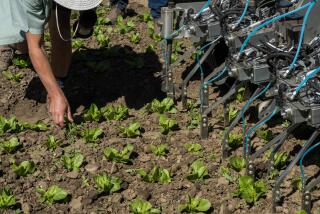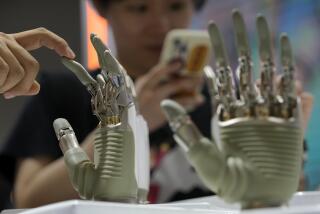Democratizing manufacturing, minus the people
Itâs not time yet to pay tribute to our new computer overlords -- even futurist Ray Kurzweil doesnât believe artificial intelligence will reach human-level aptitude until 2029. But manufacturing workers should start pondering whether smart machines and new manufacturing processes leave much room for them on the assembly line.
That was one of the messages coming out of the Techonomy 2012 conference in Tucson this week. And as much as it sounded like a warning for policymakers about how hard it may be to attain full employment in the United States, it also conveyed the hopeful prospect of an era where just about anyone with an idea can become a manufacturer.
A crucial development has been the emergence of 3D printing technology, which enables people to create objects out of images from a 3D scanner. The chief executives of two companies that offer 3D printing services -- Ping Fu of Geomagic and Peter Weijmarshausen of Shapeways -- showed off several products their printers had made, including an electric guitar formed from thick nylon and paper, a prosthetic leg, elaborate metal sculptures, a collapsible table and a ceramic cup.
The technology has significant limits, most notably the relatively small number of substances that can be printed on (including, according to Fu, paper, plastic, rubber and seven different types of metal) and the inability to print objects made from multiple materials (the various parts of the aforementioned guitar were printed separately, then assembled). Nor can 3D printers generate large objects, such as rafters for a house. But Fu and Weijmarshausen said these hurdles would be overcome in time.
In fact, Xeroxâs Palo Alto Research Center is already developing ways to print electronics and to print mechanical structures and electronics together, said Stephen Hoover, chief executive of PARC. He predicted the initial applications will emerge in about two years, including wearable sensors that can be put onto any product. Other possibilities include printed batteries, memory chips and displays. âThe performance isnât as high as traditional electronics,â Hoover conceded. âBut for a lot of things you donât really need high performance. You just want cheap and customized.â
The most radical aspect of 3D printing is that, according to Weijmarshausen, itâs no more expensive to print 1,000 different versions of one product than it is to print 1,000 copies of the same product. âThe printers donât care about the numbers,â he said.
The implication is that manufacturing can be done on an on-demand basis, rather than making products in advance to satisfy guesstimated sales. There will continue to be large-scale consumer products companies such as Apple that will mass-produce items. But 3D printing opens the door to âIT-enabled cottage industriesâ that donât have to âbuild a lot of things and try to predict what people want,â Fu said.
And itâs already in wide use in some customized products, such as the fitted in-ear shell for hearing aids, Fu said. Whereas the best employees used to make eight such shells per day by hand, Fu said, a high school student can now make 500 a day with 3D printing. Weijmarshausen added that once the right materials are developed, hip replacements and other medical implants will be obvious candidates for this kind of manufacturing.
3D printing is just one part of a larger trend democratizing design and production, Hoover of PARC said. âWe can imagine assembly automation and 3D printing combiningâ with other automation techniques into âa virtual supply chain,â Hoover said. In other words, would-be manufacturers wonât have to become experts in the different processes used for the various materials and components in their products. Theyâll be able to pull those capabilities together from various design and manufacturing services.
Thatâs not necessarily a good thing for employment, especially when you consider the longstanding trend toward automation in product assembly. If a single high-school kid can do the work of 50 skilled craftsmen, what happens to those 50 jobs? Manufacturers in the United States have been shedding labor for decades, even as they steadily increase their output. And the pace of automation may only accelerate, Hoover said, because of the capability of todayâs computers to sense, respond and adapt to the world around them. Those capabilities âwill revolutionize how things are made,â Hoover said.
One example discussed at the conference was Baxter (shown above), a $25,000 assembly-line robot due next year from Rethink Robotics. According to Rodney Brooks, the founder of Rethink (and a co-founder of iRobot, maker of the Roomba robotic vacuum cleaner), Baxter can easily be programmed in a matter of minutes to do many types of repetitive tasks, such as retrieving and placing objects. Although itâs not suited for precision work, Brooks said, the robotâs software is flexible enough for independent developers to write their own applications and stretch Baxterâs limits.
But Brooks doesnât see Baxter as a replacement for workers. He sees it as a better tool that increases the value of human labor. âThe computer didnât get rid of the office worker,â Brooks noted. âIt changed the nature of the work the office-worker did.â
ALSO:
The pros and cons of fiddling with the global thermostat
Follow Jon Healey on Twitter @jcahealey
More to Read
A cure for the common opinion
Get thought-provoking perspectives with our weekly newsletter.
You may occasionally receive promotional content from the Los Angeles Times.











